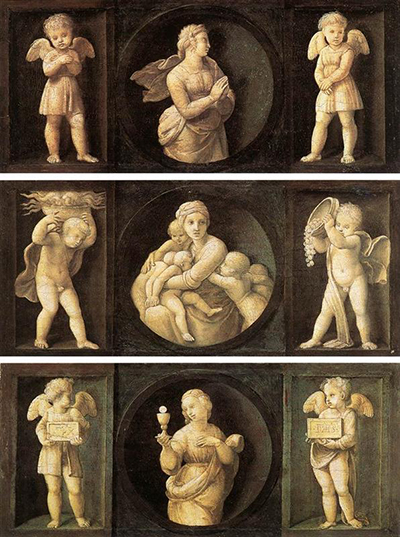The Cardinal and Theological Virtues by Raphael is a decorative lunette fresco painting. Pope Julius II from the della Rovere family commissioned it at the beginning of the 16th century.
The pope requested three consecutive paintings after this. These are the Cardinal and Theological Virtues these are the Disputation of the Holy Sacrament, The Parnassus and The School of Athens. The masterpiece is now located on the southern wall in Stanza della Segnatura. This is an Apostolic Palace of the Vatican. The painting was completed after the Disputation of the Holy Sacrament. The three women on the painting represent three Cardinal virtues that is fortitude, prudence and temperance. The theological virtues, on the other hand, are represented by the cupids. These are charity, hope, and faith.
The fresco was commissioned and painted in 1511 to decorate the Pope Julius the II's private apartments. These rooms have been named as the Stanze di Raffaello. The painting was part of Raphael's Stanza della Segnatura. It is about 6.6m wide at the base and is semi-circular in shape. The collection was held in Palazzi Vatican in the Vatican City. The structure of the art is highly symbolic and the most detailed masterpiece. All the aspects of the picture have a representation of the real world’s design. The woman holding an oak branch, for instance, which is shaken, represents courage, the one with two faces and a cupid holding a flaming torch represents prudence, while the other, who holds reigns in her hands and guards the cupid, is temperance.
Prudence is well placed in the centre. On her breast lies an effigy, which is winged Gorgon. It is meant to do away with deceit and fraud. Temperance, on the other hand, sits by the right. She holds a prominent position to show Justice. The walls depict four main aspects of human knowledge. These are philosophy, religion, poetry and law. The forth wall containing the virtues depicts on both the civil law and the canon law of the church. On the left side, Raphael painted a resilience. This is an Armour-clad who is carelessly caressing a lion with her left hand and holds a sampling of black oak on the other. The oak tree is said to symbolise strength, which is implied of the Della Rovere family.
Just like most of his paintings, Raphael used the oil paint. After careful analysis, scientists can determine the materials that were used by Raphael during his paintings, especially after settling in Rome. However, this is the painting that was done in great detail. The shadowing and colouring of the painting structure were done with extensive care. After employing assistants, it was difficult to disseminate his paintings from his students. The Cardinal masterpiece is currently located on a wall opposite to the Parnassus. The Theological virtues in the painting are located above and below the windows. It is next to a painting by Lorenzo Lotto of the Delivery of the Pandect.




